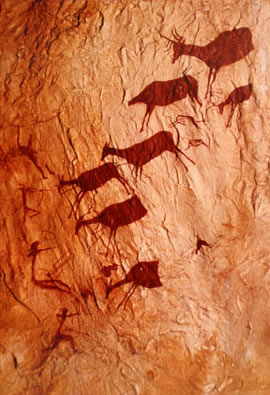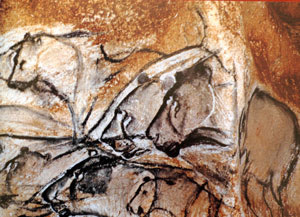Figures Traced in Light: On Cinematic
Staging
[1] Introduction
[2] Revising Our Sense
of Feuillade
[3] Mizoguchi the Inexhaustible
[4] Cheerful Staging: Hou’s
Early Films
[5] Staging and Stylistics:
Some Further Business
[6] Misprints, Mistakes, and Missed
Opportunities
Staging and Stylistics: Some Further Business
I hesitated to launch counterarguments in the final chapter of Figures Traced in Light. The standard strategy is to disarm your critics at the outset before proceeding to mount a positive case. But this would have created problems for the book. First, as Figures was in some ways an extension of On the History of Film Style, to defend the earlier book from objections at the outset might have put readers off. (“Is this guy touchy or what?”) Moreover, I wanted to show how my approach to staging worked in detail before rebutting critics of that approach. If the reader followed my analyses up to the final chapter, I hoped that my reply to objections would carry more conviction. Finally, I wanted the final chapter to push my detailed studies into a broader realm, and my critics offered me many opportunities to do that—exactly because they usually objected to my approach on general grounds. A couple of Web correspondents have mentioned that the last chapter seemed to them a bit daunting, so I probably lost as much as I gained by this strategy.
In any event, I take this opportunity to carry some of my points further in the malleable medium of the Internet.
One last note: My comments in Figures on Slavoj Žižek’s critique (pp. 260–264) were confined to his objections to my discussions of style. Žižek has many other objections to my orientation, particularly as set forth in a volume I edited with Noël Carroll, Post-Theory. In the online essay Slavoj Žižek: Say Anything I reply to Žižek’s more wide-ranging points.
Stylistics and Craft Practice: Issues of Intention
When I wrote this chapter, I didn’t have available Paisley Livingston’s excellent new book, Art and Intention: A Philosophical Study (Oxford: Oxford University Press, 2005). Livingston untangles many issues around artistic decision-making, and he does it in ways more sophisticated than I can. Still, the book supports, I think, my assumptions that stylistics can appeal to the patterns of craft choices as revealing intentions within a believe-desire, means-ends framework.
An accessory pleasure of Livingston’s book is his habit of mounting dry asides to some of the wilder claims of contemporary literary/film theory. His treatment of Foucault is at once respectful, subtle, and skeptical, pointing out that Foucault’s account of authorship leads to an infinite regress (p. 67). And in discussing Borges’s story about Pierre Menard, who wrote a version of Don Quixote identical to Cervantes’ book, Livingston responds to post-structuralist beliefs that single art works dissolve into a sea of indeterminate textuality with this:
If text and textuality are always already indeterminate and in a condition of perpetual flux and deferral, how could Cervantes and Menard generate anything that could rightly be recognized as being “verbally identical”? As the proponents of theories of a sublime and wholly indeterminate textuality regularly rely on such textual identifications (they are, for example, quick to complain if they are misquoted), their accounts of textuality are most charitably understood not as plausible definitions but as exhortations to engage in creative and transgressive interpretation (125).
Representational Relativism
People who don’t spend time in seminar rooms will probably be surprised to learn that many academics studying the visual arts believe that there are no universals of pictorial representation. They believe that the persons, places, and things depicted in images are presented by means of conventions that vary maximally across cultures. Pictures are “arbitrary” representations, in that they consist of symbol systems that might have been radically otherwise.
By assuming the radical arbitrariness of pictures, the theorist can deny that there are any interesting common features of human nature. Human nature, many believe, is a monstrous hoax, an ideological construction that affirms “the great family of man” and thus erases the specificity of social struggles. For most theorists, all meanings are local and “historically situated,” tied firmly to one culture at one time and place. Once this position is granted, the theorist can go on to point out how any image is shot through with local social meanings. The theorist can always ask, right out of the gate, what ideological work the picture is performing. How, for example, does a picture of a woman exaggerate her sexual appeal to men? (The classic essay here is John Berger’s Ways of Seeing.)
Chapter 6 of Figures argues that this position is flawed. There’s no reason to believe that pointing out cross-cultural affinities in any way makes us lose a sense of local differences. A picture is a representational package, evoking at once very broadly based responses (e.g., the perceptual process of detecting edges of figures) and quite local ones (e.g., the modes of dress, the use of color). These responses are in a complex tangle, but it’s wrong to deny that all these strands exist. If we want full explanations of why images look as they do, we can usefully invoke as either causes or preconditions the human propensity to make images that in important respects resemble the world.
But resemble it in what ways? Many theorists came to believe in the ultimate arbitrariness of images because they thought that the case for the cross-cultural commonality of visual representation rested upon perspective drawing. If they could show that perspective was arbitrary and culturally provincial, then there was no other candidate for pan-human picture-making. This position was given impetus, among French theorists particularly, by the art historian Pierre Francastel. In La Figure et le lieu (Gallimard, 1967) and other works, Francastel sought to show the ideological sources of what he called “the perspective cube,” the principles of spatial organization found in Renaissance pictures. His ideas proved important for Cahiers du cinéma’s examination of deep-focus in the cinema in the late 1960s and early 1970s.
General principles of perspective construction—e.g., scaling figures to approximate sizes, or arranging figures to suggest relative distances, or overlapping planes to indicate depth—includes design principles common to many (but not all) image-making traditions. And perspective in the narrower sense of “geometrical” perspective (with vanishing points and receding orthogonals) is more culturally specific. But at least one principle seems common to all traditions. An outline drawing of familiar figures, not necessarily arrayed in an overall spatial whole, is a good candidate for a contingent universal of picture-making.

Fig. 6A.1
Deer hunt from Cavalls cave, near Valltorta, Spain. From Clottes, World Rock Art, p. 98. Note sticklike human figures on left and canonical profile views of the deer.
|

Fig. 6A.2
A pride of lions, again in profile, from the Grotte Chauvet cave. Painted by Cro‑Magnons, they are at least thirty thousand years old, yet astonishingly realistic by any standard. From Clottes, World Rock Art, p. 45. |
Look at an ancient Egyptian tomb painting, and you will see people (often distorted in their proportions, but recognizably human), along with birds, beasts, flowers, fish, chariots, furniture, food, bowls, goblets, and the like—many rendered in striking detail. In Figures, I allude to Ice Age cave paintings that represent all manner of creatures in immediately recognizable ways. Since writing that chapter, I have found Jean Clottes’s wonderful World Rock Art (Los Angeles: The Getty Conservation Institute, 2002), which amply shows the universality of outline drawing. Such representations appear in every inhabited region, they go back very far (perhaps fifty thousand years), and they are remarkably readable to us today. While the pictures of humans are somewhat stylized (there seems to be a preference for sticklike figures, often distended), other things are presented as vivid, even “realistic” in a modern sense (Figs. 6A.1 and 6A.2).
The conclusion seems inescapable. We see things in the world as having boundaries and edges. Our visual system, like a PhotoShop edge-enhancer, sharpens the softer gradients given in early stages of vision. These perceptual processes, which we share with our distant ancestors, bias us toward rendering the contours we see by means of a mark. “Lines stand for edges” is a simple, apparently universal maxim of picture-making.
There seem to be other universals too. Within a range, figures retain relative proportions; we can recognize humans even if they’re wildly stretched. The figures also present strong geometrical cues (symmetry) as well as real-world referents (so humans have, as a default, two arms, two legs). Certain objects are rendered in canonical ways; fish are instantly recognizable, being almost always drawn in profile.
So theorists set the bar too high by focusing the case for representational relativism on perspective, which seems quite specific to certain cultures. Yet Margaret Hagen has mounted a very intriguing argument that a range of optical projection systems, including station-point perspective, can account for a great deal of the world’s art. Her Varieties of Realism: Geometries of Representational Art (Cambridge University Press, 1986) is curiously ignored, so far as I can tell, by both art historians and theorists of visual representation, but it offers a systematic account of similarities and differences among many pictorial systems. It turns out that there aren’t infinitely many such systems, and Hagen convincingly shows that each one taps into some relevant information about the visible world.
In any event, the commonalities among representational systems aren’t just perceptual ones. In Figures, I mention that there are also social regularities across cultures. People face one another when they speak, and they scan each other’s facial expressions for clues to attitudes. Clottes’s book calls attention to other common elements, such as scenes of hunting (Fig. 6A.1) and warfare. Such regularities of social exchange and action are supported, I believe, by a stock of concepts that arise whenever humans form a society. (We are social animals.) Concepts of kinship, enmity, sexual jealousy, and the like seem fundamental to any culture, and though they aren’t given in perception, they are good candidates for cultural universals—and thus pictorial representation. By the way, such social universals also figure into narrative construction. Belief/desire psychology and informal means/ends reasoning seem to be central to a great many stories, and as Patrick Hogan shows in his brilliant book, The Mind’s Stories, the actions these capacities generate can often be correlated with some widespread conceptions of human emotional fulfillment.
It’s important to stress the argument for the cross-cultural side of image-making on sheerly theoretical grounds. Doing so enables us to launch a discussion of what many humanities academics, particularly those who engage in Cultural Studies, have taken for granted: an overly broad relativism about representational options. My immediate purposes in Figures, though, were more specific. First, I wanted to show that a many patterns of cinematic staging appeal to transcultural regularities of human perception and cognition. Viewers outside Japan can grasp a great deal of what’s going on in a Mizoguchi scene simply by paying attention. Additionally, evidence for convergence in techniques of making pictures helps support my claims about the cross-cultural reach of film craft (pp. 258–260). In this way filmmakers in different times and places might hit upon some common stylistic tactics, without there being demonstrable influences.
So we need not explain everything interesting about the way films look and sound by recourse to local cultural factors. When particular patterns of staging are “rediscovered” by filmmakers working in very different circumstances, it’s plausible to think that the concrete and proximate choices filmmakers make owe something to longer-standing traditions.
© David Bordwell 2006. [1] Introduction
[2] Revising Our Sense
of Feuillade
[3] Mizoguchi the Inexhaustible
[4] Cheerful Staging: Hou’s
Early Films
[5] Staging and Stylistics:
Some Further Business
[6] Misprints, Mistakes, and Missed
Opportunities
|
|



